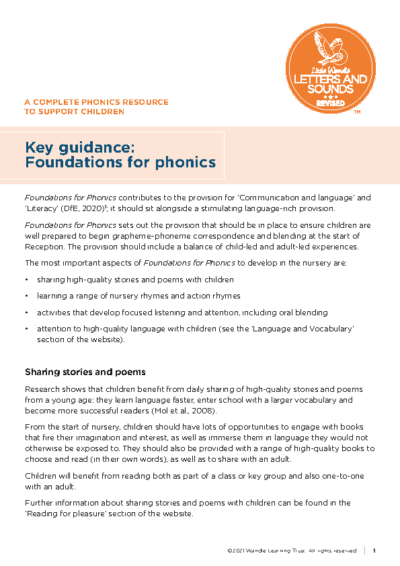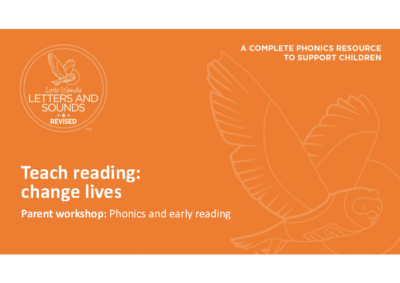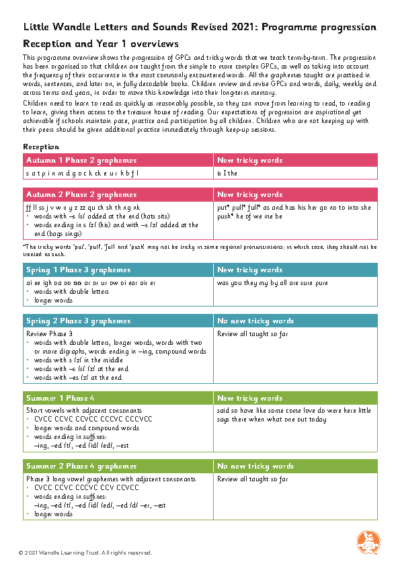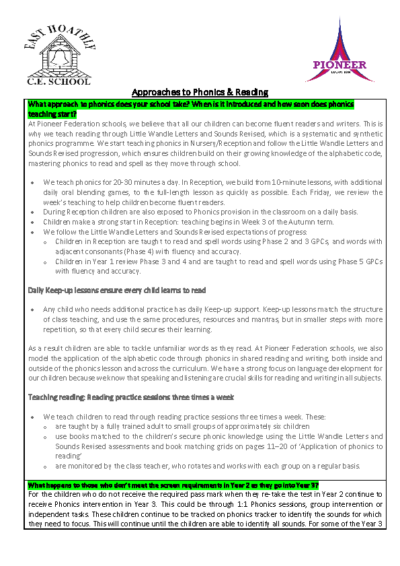The context of our Federation
The Pioneer Federation has a rigorous whole school approach to the teaching of phonics through daily teaching sessions and ongoing assessment. All children in Nursery, Reception and Year 1 will be taught phonic skills through a range of teaching methods. It is essential that our approach to teaching phonics and reading is accessible to all learners, regardless of background.
Intent
Phonics (reading and spelling)
At Pioneer Federation schools, we believe that all our children can become fluent readers and writers. This is why we teach reading through Little Wandle Letters and Sounds Revised, which is a systematic and synthetic phonics programme. We start teaching phonics in Nursery/Reception and follow the Little Wandle Letters and Sounds Revised progression, which ensures children build on their growing knowledge of the alphabetic code, mastering phonics to read and spell as they move through school.
As a result, all our children are able to tackle any unfamiliar words as they read. At Pioneer Federation schools, we also model the application of the alphabetic code through phonics in shared reading and writing, both inside and outside of the phonics lesson and across the curriculum. We have a strong focus on language development for our children because we know that speaking and listening are crucial skills for reading and writing in all subjects.
Comprehension
At Pioneer Federation schools, we value reading as a crucial life skill. By the time children leave us, they read confidently for meaning and regularly enjoy reading for pleasure. Our readers are equipped with the tools to tackle unfamiliar vocabulary. We encourage our children to see themselves as readers for both pleasure and purpose.
Because we believe teaching every child to read is so important, we have a Reading Leader who drives the early reading programme in our schools. This person is highly skilled at teaching phonics and reading, and they monitor and support our reading team, so everyone teaches with fidelity to the Little Wandle Letters and Sounds Revised programme.
Implementation
Foundations for phonics in Nursery
- We provide a balance of child-led and adult-led experiences for all children that meet the curriculum expectations for ‘Communication and language’ and ‘Literacy’. These include:
- sharing high-quality stories and poems
- learning a range of nursery rhymes and action rhymes
- activities that develop focused listening and attention, including oral blending
- attention to high-quality language.
- We ensure Nursery children are well prepared to begin learning grapheme-phoneme correspondences (GPCs) and blending in Reception.
Daily phonics lessons in Reception and Year 1
- We teach phonics for 20-30 minutes a day. In Reception, we build from 10-minute lessons, with additional daily oral blending games, to the full-length lesson as quickly as possible. Each Friday, we review the week’s teaching to help children become fluent readers.
- During Reception children are also exposed to Phonics provision in the classroom on a daily basis.
- Children make a strong start in Reception: teaching begins in Week 3 of the Autumn term.
- We follow the Little Wandle Letters and Sounds Revised expectations of progress:
- Children in Reception are taught to read and spell words using Phase 2 and 3 GPCs, and words with adjacent consonants (Phase 4) with fluency and accuracy.
- Children in Year 1 review Phase 3 and 4 and are taught to read and spell words using Phase 5 GPCs with fluency and accuracy.
Daily Keep-up lessons ensure every child learns to read
- Any child who needs additional practice has daily Keep-up support, taught by a fully trained adult. Keep-up lessons match the structure of class teaching, and use the same procedures, resources and mantras, but in smaller steps with more repetition, so that every child secures their learning.
- We timetable daily phonics lessons for any child in Year 2 or 3 who is not fully fluent at reading or has not passed the Phonics screening check. These children urgently need to catch up, so the gap between themselves and their peers does not widen. We use the Little Wandle Letters and Sounds Revised assessments to identify the gaps in their phonic knowledge and teach to these using the Keep-up resources – at pace.
- If any child in Year 3 to 6 has gaps in their phonic knowledge when reading or writing, we plan phonics ‘catch-up’ lessons to address specific reading/writing gaps. These short, sharp lessons last 10 minutes and take place at least three times a week.
Teaching reading: Reading practice sessions three times a week
- We teach children to read through reading practice sessions three times a week. These:
- are taught by a fully trained adult to small groups of approximately six children
- use books matched to the children’s secure phonic knowledge using the Little Wandle Letters and Sounds Revised assessments and book matching grids on pages 11–20 of ‘Application of phonics to reading’
- are monitored by the class teacher, who rotates and works with each group on a regular basis.
- Each reading practice session has a clear focus, so that the demands of the session do not overload the children’s working memory. The reading practice sessions have been designed to focus on three key reading skills:
- decoding
- prosody: teaching children to read with understanding and expression
- comprehension: teaching children to understand the text.
- In Reception these sessions start in Week 4. Children who are not yet decoding have daily additional blending practice in small groups, so that they quickly learn to blend and can begin to read books.
- In Year 2 and 3, we continue to teach reading in this way for any children who still need to practise reading with decodable books.
Home reading
- The decodable reading practice book is taken home to ensure success is shared with the family.
- Reading for pleasure books also go home for parents to share and read to children.
- We use the Little Wandle Letters and Sounds Revised parents’ resources to engage our families and share information about phonics, the benefits of sharing books, how children learn to blend and other aspects of our provision, both online and through workshops.
Impact
Assessment
Assessment is used to monitor progress and to identify any child needing additional support as soon as they need it.
- Assessment for learning is used:
- daily within class to identify children needing Keep-up support
- weekly in the Review lesson to assess gaps, address these immediately and secure fluency of GPCs, words and spellings.
- Summative assessment is used:
- every six weeks to assess progress, to identify gaps in learning that need to be addressed, to identify any children needing additional support and to plan the Keep-up support that they need.
- by SLT and scrutinised through the Little Wandle Letters and Sounds Revised assessment tracker, to narrow attainment gaps between different groups of children and so that any additional support for teachers can be put into place.
- The Little Wandle Letters and Sounds Revised placement assessment is used:
- with any child new to the school to quickly identify any gaps in their phonic knowledge and plan provide appropriate extra teaching.
Statutory assessment
- Children in Year 1 sit the Phonics screening check. Any child not passing the check re-sits it in Year 2.
Ongoing assessment for catch-up
- Children in Year 2 to 6 are assessed through:
- their teacher’s ongoing formative assessment
- the Little Wandle Letters and Sounds placement assessment
- the appropriate half-termly assessments.
Key Terms We Use in Our Teaching
| Digraph | two letters make one sound (e.g. sh, ch, ai, ea, ou, ow) |
| Trigraph | three letters make one sound (e.g. igh, ear, air, ure) |
| Split digraph | two letters make one sound but the letters have been split apart by another letter. (e.g. the a - e sound in cape) |
| Phoneme | a single unit of sound |
| Grapheme | a written letter, or group of letter that represent a sound |
| Consonants | b, c, d, f, g, h, j, k, l, m, n, p, q, r, s, t, v, w, x, y, z |
| Blend | to put or merge the sounds together to make a word (e.g. the sounds d-o-g are blended to the word ‘dog’) |
| Segment | to break down the word into its individual sounds to spell (e.g cat can be split into the sounds c-a-t.) |
| Sound buttons | ways of visually isolating different sounds in a word. We use a dot under letters where one letter makes one sound and a line understand digraphs or trigraphs |
Why do we use Little Wandle Letters and Sounds?
At Pioneer Federatation schools, we use the Little Wandle Letters and Sounds systematic synthetic phonics programme (SSP).
This is a fully comprehensive programme where children start learning single letter sounds in the autumn term of their Reception year. It builds on their sounds showing progression throughout; preparing children for the statutory phonics screening that takes place at the end of year 1.
Previously, we used a variety of teaching methods including: The Letters and Sounds framework, Jolly Phonics letter sounds and PhonicsPlay planning. As a result of this, children’s Phonics learning was not consistent across the federation. At times, books were not always at the best level for individual children, our resources were limited and not always suitably linked to children’s Phonics level. Therefore, as we were not using a consistent Phonics scheme, we decided we needed cohesion through reading by putting in a place a systematic approach to reading progression.
Before deciding upon a Phonics scheme, we trialled a variety of schemes that were available and researched the websites for available resources and feedback. Also, spoke to staff in other schools using full SSP’s to hear how they were finding applying these to teach Phonics. Through this research, we were able to decide upon a scheme that would be suitable for teaching in Pioneer federations schools. Little Wandle Letters and Sounds programme provides teaching from Nursery onwards which supports the teaching of Phonics within our Nursery, alongside our schools. Also, Little Wandle provides catch-up resources to support pupils who need further intervention to support their Phonics learning.
Phonics is taught every day and children learn to apply their phonics skills in reading practise sessions 3 times a week, developing their fluency and comprehension skills along the way.





